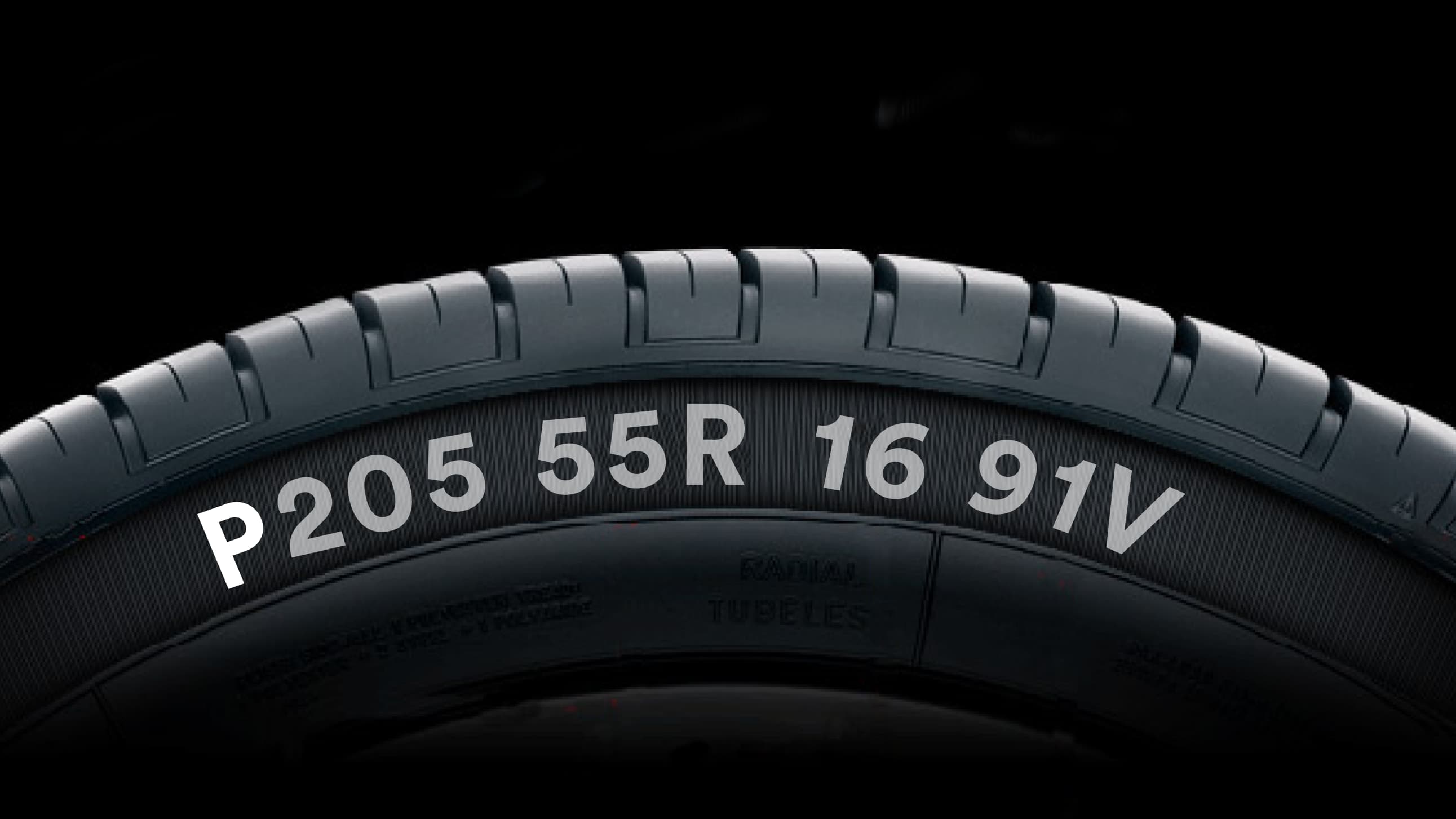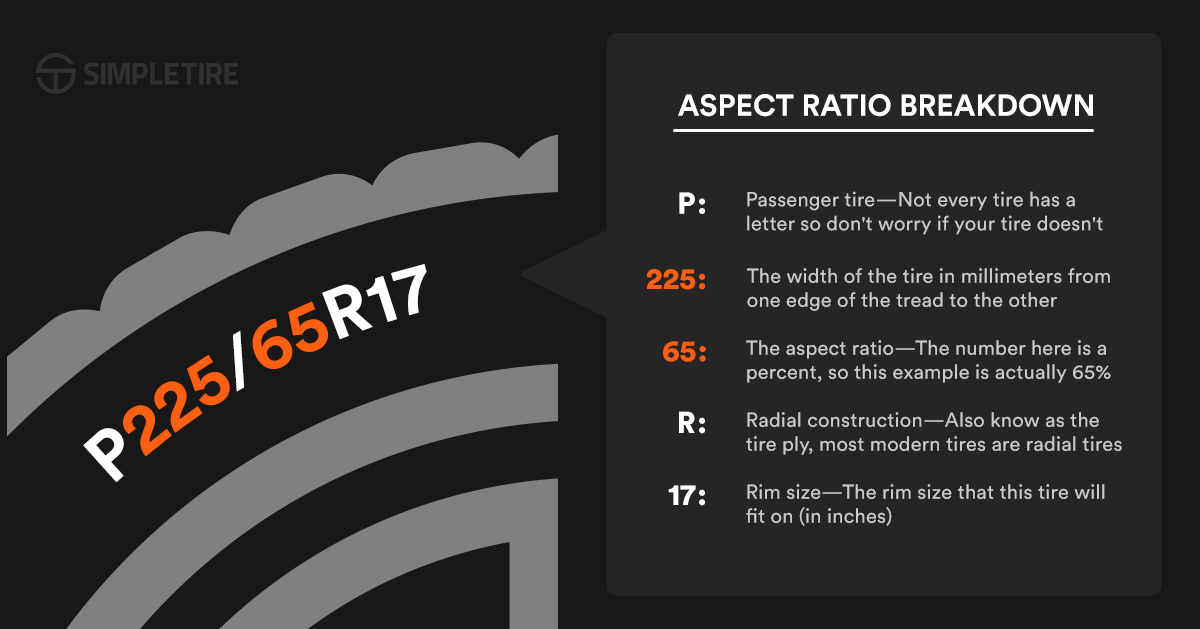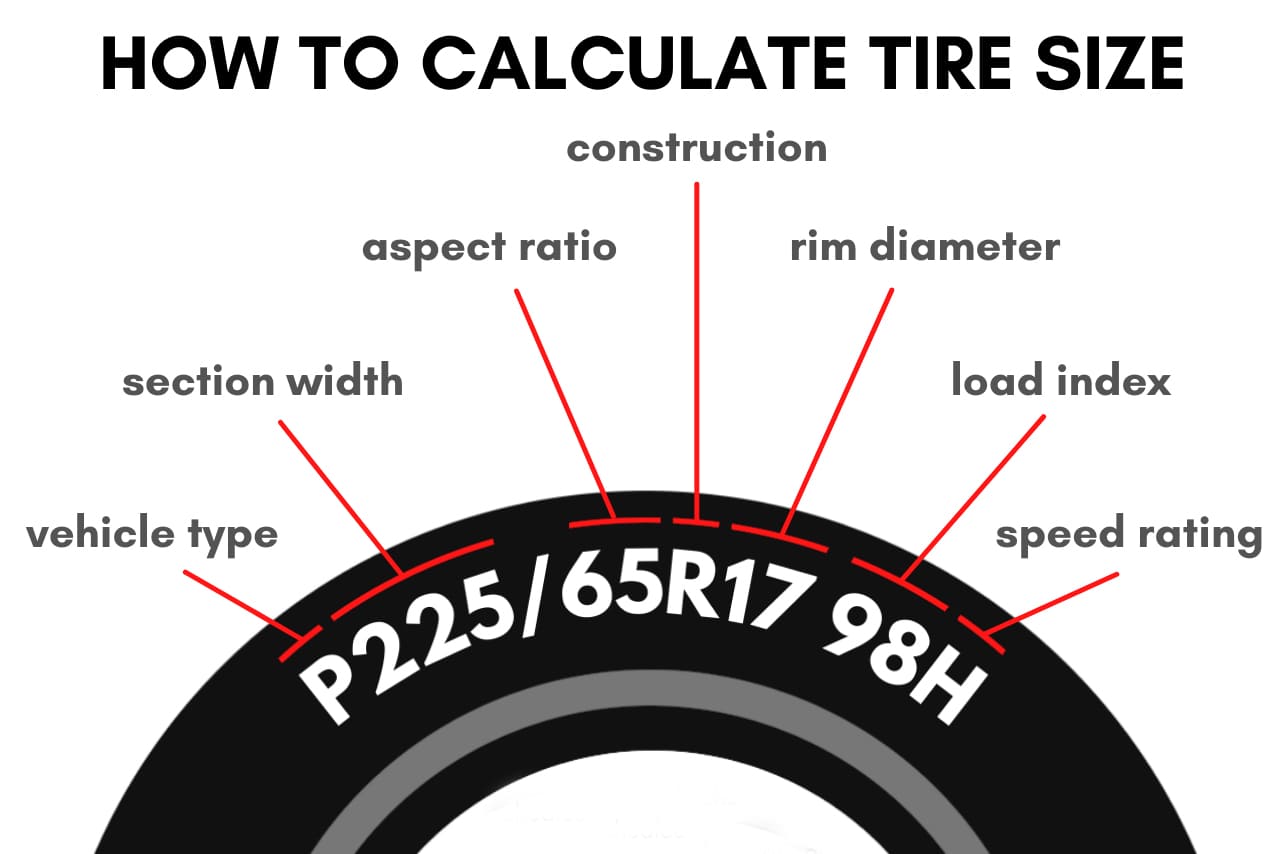Tire Maintenance & Safety
Free shipping
Best price guarantee
Special pricing
Financing with Resolve
Easy returns

Deciphering the cryptic numbers and letters on your tire sidewalls may seem daunting at first glance. However, understanding these markings is crucial for ensuring you have the right tires for your vehicle, optimizing performance, and maintaining safety on the road.
Tire size numbers provide essential information about the tire's specifications, helping you identify the perfect fit for your car, truck, or SUV. By familiarizing yourself with these codes, you can make informed decisions when purchasing new tires or maintaining your current set.
In this article, we'll break down the components of tire size numbers, empowering you to choose the right tires confidently. Let's dive in and learn how to read tire numbers like a pro.
What Are Tire Size Numbers?
Tire size numbers are a combination of letters and digits that convey crucial information about a tire's dimensions, load capacity, speed rating, and construction type. These markings, found on the sidewall of every tire, follow a standardized format set by the U.S. Tire and Rim Association (USTRA) and the European Tyre and Rim Technical Organisation (ETRTO).
Understanding tire size numbers is essential for several reasons:
- Ensuring proper fit: Tires must match the specifications recommended by your vehicle manufacturer for optimal performance and safety. Using tires with incorrect size numbers can lead to poor handling, increased wear, and even damage to your vehicle's suspension or bodywork.
- Maintaining load capacity: The load index, indicated by a number within the tire size code, specifies the maximum weight each tire can support when properly inflated. Choosing tires with an appropriate load index ensures your vehicle remains stable and safe, especially when carrying heavy cargo or towing.
- Matching speed capabilities: The speed rating, denoted by a letter at the end of the tire size code, indicates the maximum speed at which the tire can safely operate. Selecting tires with a speed rating that matches or exceeds your vehicle's capabilities is crucial for maintaining control and preventing tire failure at high speeds.
By decoding tire size numbers, you can make informed decisions when replacing worn tires or upgrading to a different type of tire. This knowledge also comes in handy when shopping for tires online, such as through SimpleTire, where you can easily filter options based on your vehicle's specific tire size requirements.
In the following sections, we'll delve into the individual components of tire size numbers, providing you with the tools to decipher these codes like a seasoned professional. Armed with this information, you'll be well-equipped to select the perfect tires for your vehicle, ensuring a safe and comfortable ride for years to come.
How to Interpret Tire Size Numbers

Understanding tire size numbers is crucial for selecting the right tires for your vehicle. By breaking down the components, you gain insight into the specific characteristics each tire offers.
1. Tire Type Code
Understanding the tire type code is essential for identifying the tire's specific application, ensuring compatibility with different vehicle categories. This code, either a letter or its absence, reveals vital information about the tire's design purpose, aiding in the selection process for optimal performance.
Passenger, Light Truck, and Special Trailer Tires
- Passenger Vehicles (P): Tires with a 'P' label are tailored for passenger cars, including sedans and minivans. They focus on delivering a smooth ride and improved fuel efficiency, making them ideal for daily commuting.
- Light Trucks (LT): The 'LT' designation refers to light truck tires, crafted for vehicles like pickups and SUVs that require support for heavier cargo and towing. These tires feature reinforced construction to handle tough conditions and heavier loads.
- Special Trailers (ST): Tires marked with 'ST' are specifically for trailers, such as travel trailers or boat trailers. They are engineered to cope with the unique demands of towing, providing stability and strength for safe transport.
Metric Tires
In some instances, the absence of a leading letter signals a metric tire, particularly common in vehicles from European markets. These tires follow a different sizing convention, often resulting in varied load capacities compared to their passenger or truck counterparts. Familiarity with this distinction ensures the correct tire choice for imported vehicles requiring precise specifications.
Recognizing these tire type codes empowers you with the knowledge to select tires that meet your vehicle's specific requirements and enhance driving safety and efficiency.
2. Tire Width
Tire width is a critical factor that influences how a vehicle interacts with the road surface. Displayed as a three-digit number following the type code, it measures the span in millimeters from one side of the tire to the other. This precise measurement ensures the tire aligns correctly with the wheel, maintaining the vehicle's balance and performance.
Importance of Accurate Tire Width
- Enhanced Performance: A greater tire width typically provides increased road contact, which can improve traction during acceleration and cornering. This width is particularly advantageous for vehicles that demand high performance and stability.
- Impact on Efficiency: While a wider tire offers better grip, it can also lead to increased rolling resistance, potentially affecting fuel efficiency. Conversely, narrower tires may save fuel but might compromise traction in certain conditions.
- Proper Wheel Integration: Selecting the right tire width is essential for avoiding potential fitment issues. An incorrect width can lead to rubbing against the vehicle’s body or suspension, causing damage or uneven tire wear over time.
Choosing the Right Tire Width
Making an informed choice about tire width involves understanding your vehicle's specific requirements and your driving conditions. It's important to adhere to the recommended tire specifications listed in the vehicle's manual or on the information placard. This ensures the tires work harmoniously with the vehicle's engineering, providing a safe and efficient driving experience.
3. Aspect Ratio
Aspect ratio plays a critical role in determining a tire's profile and the overall driving experience. This ratio, expressed as a percentage, defines how the height of the tire's sidewall compares to its width. Grasping this concept allows you to choose tires that align with your vehicle's performance characteristics and your driving preferences.
Impact on Driving Dynamics
Tires with a lower aspect ratio, characterized by a shorter sidewall, often deliver sharper handling and increased responsiveness. Such tires enhance cornering stability and provide a sportier driving feel, making them ideal for performance-oriented vehicles. However, they may transmit more road noise and bumps, potentially affecting ride comfort.
In contrast, a higher aspect ratio results in a taller sidewall, which can cushion the ride by absorbing more road irregularities. This feature is beneficial for vehicles where comfort is a priority, such as family sedans or crossovers designed for leisurely driving.
Aligning Tires with Your Needs
When selecting tires, consider how aspect ratio influences the driving experience specific to your needs. A lower aspect ratio can be advantageous for those who enjoy dynamic driving on curvy roads. If your daily travels are predominantly on highways or city streets, a higher aspect ratio might provide the comfort and longevity you seek. Understanding these nuances ensures that your tire choice enhances your vehicle's capabilities and meets your expectations on the road.
4. Construction Type

The construction type of a tire provides insight into its internal build, indicated by a single letter on the sidewall. This letter is crucial for understanding how the tire is constructed, impacting its performance and compatibility with various vehicles. Recognizing this component aids in selecting tires that align with your vehicle's suspension system and specific driving requirements.
Radial Construction
Radial tires, marked with 'R', are the most common type used today. They are designed with steel belts running at a 90-degree angle from the tread centerline. This construction offers distinct benefits:
- Superior Ride Comfort: The design minimizes sidewall flex, allowing for a smoother ride over uneven surfaces.
- Enhanced Road Contact: Radial tires maintain consistent grip, improving stability and traction during various driving conditions.
- Longer Tread Life: The even distribution of pressure across the tire surface helps reduce wear and extend tire longevity.
Alternative Construction Types
While radial tires are prevalent, other types like bias-ply offer unique features for certain applications. Bias-ply construction, lacking an 'R', involves layers of fabric running diagonally across the tire:
- Robust Sidewalls: Ideal for vehicles that encounter rugged terrains, providing durability and strength.
- Cost-Effective Solution: Often more affordable, suitable for vehicles where high-performance features are less critical.
Understanding the construction type is essential for ensuring that the tires you choose are compatible with your vehicle's suspension, delivering the desired balance of comfort, durability, and performance.
5. Wheel Diameter
Wheel diameter, a key aspect of tire size, indicates the compatibility between the tire and the wheel. Expressed as a two-digit number following the construction type, it specifies the wheel's diameter in inches. This measurement is crucial for ensuring the tire fits the wheel precisely, which is essential for maintaining the vehicle's handling and safety.
Importance of Proper Wheel Diameter
A correctly sized wheel diameter ensures that the tire mounts securely onto the wheel rim. This precise fitment is vital for preventing issues such as tire slippage or poor alignment, which can lead to uneven tire wear or compromised vehicle stability. Additionally, matching wheel diameter with tire specifications helps maintain the vehicle's suspension system, allowing for optimal shock absorption and comfort.
Selecting the appropriate wheel diameter also influences a vehicle's overall look and driving dynamics. Smaller diameters can offer a smoother ride by providing more sidewall cushioning, while larger diameters might improve handling by lowering the vehicle's center of gravity and enhancing cornering ability.
Choosing the Right Wheel Diameter for Your Vehicle
When selecting tires, it's essential to follow the wheel diameter specifications provided by the vehicle manufacturer. This information is typically located in the owner's manual or on the vehicle's tire information placard. Ensuring the correct diameter not only helps maintain safety and performance but also aligns with the vehicle's design and engineering standards.
In some cases, drivers may choose to alter their wheel size for aesthetic or performance enhancements. While this can change the vehicle's appearance or handling, it's important to consult with a tire professional to ensure that the new diameter is suitable for the vehicle's capabilities and does not negatively impact its operation.
6. Load Index

The load index is an essential component found at the end of the tire size code, detailing the weight capacity each tire can handle. This number is crucial for ensuring that the tire is suited to the vehicle's requirements, facilitating safe and efficient operation. Understanding the load index empowers you to make informed choices when selecting tires for varying loads.
Decoding the Load Index
Each load index correlates with a specific weight limit, and these values are standardized to maintain consistency across tire models. For instance, a tire marked with a load index of 95 supports up to 1,521 pounds. An increase in the load index number signifies a tire's enhanced ability to carry heavier loads, which is particularly important for vehicles engaged in frequent towing or heavy-duty transport. Selecting tires with the right load index ensures optimal vehicle performance under various loading conditions.
Ensuring Proper Load Index
Selecting a tire with the correct load index is vital for the vehicle's overall safety and function. A mismatch can result in unnecessary strain on the tire, leading to accelerated wear or even a failure. Such a discrepancy can compromise vehicle handling and stability, which is especially crucial during high-stress situations. Therefore, reviewing the vehicle's specifications and adhering to the recommended load index guarantees that your tires can effectively support your vehicle's operational demands, contributing to a balanced and secure driving experience.
7. Speed Rating
A tire's speed rating, indicated by a letter, reveals the maximum speed the tire can handle while maintaining stability and safety. This rating is crucial for ensuring that the tire's capabilities align with how you plan to use your vehicle, whether for daily commuting or more spirited driving.
Understanding Speed Ratings
Each letter in the speed rating corresponds to a specific speed limit:
- S: Supporting up to 112 mph, typically found on family vehicles.
- T: Rated for up to 118 mph, suitable for larger sedans and crossovers.
- H: Handles up to 130 mph, often seen on sporty sedans.
- V: Designed to perform at speeds up to 149 mph, common in performance cars.
- Z: Exceeds 149 mph for high-performance sports vehicles.
Choosing the right speed rating ensures that your tires can handle the speed demands of your vehicle, which is particularly important for maintaining control at highway speeds.
Aligning Speed Ratings with Your Driving Needs
Selecting a tire with the appropriate speed rating involves understanding your driving habits and vehicle capabilities. It's essential to match the tire's speed rating to your vehicle's maximum speed to ensure optimal performance and safety. For those who enjoy driving at higher speeds, opting for a tire with a higher speed rating can provide the necessary stability and confidence. Conversely, drivers primarily focused on city or suburban routes may find that a lower speed rating meets their needs while offering a comfortable ride. Tailoring the speed rating to your specific requirements helps maintain the tire's integrity and aligns with your vehicle's performance potential.
By understanding the intricacies of tire size numbers, you can confidently select the perfect tires for your vehicle, ensuring optimal performance, safety, and longevity. Remember, investing in the right tires is an investment in your driving experience and peace of mind. When you're ready to find the best deals on tires that fit your vehicle's specific needs, shop for tires online with us at SimpleTire, where we make the tire-buying process simple and hassle-free.
Ready to find the perfect tires?
Search By